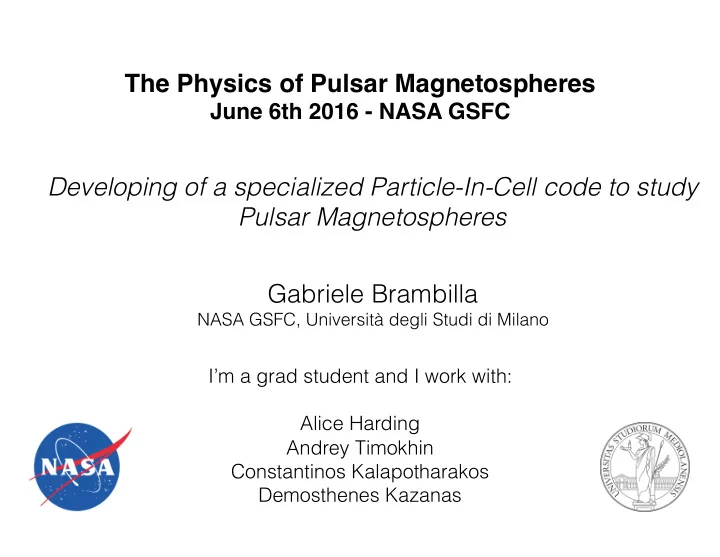

The Physics of Pulsar Magnetospheres June 6th 2016 - NASA GSFC Developing of a specialized Particle-In-Cell code to study Pulsar Magnetospheres Gabriele Brambilla NASA GSFC, Università degli Studi di Milano I’m a grad student and I work with: Alice Harding Andrey Timokhin Constantinos Kalapotharakos Demosthenes Kazanas
In PIC codes, particles moved by the fields form the currents that act on the fields themselves 3D Cartesian Electromagnetic Relativistic pusher Parallelized PML perfectly matched layer Domain size physical 3.0 R LC with PML 3.6 R LC Resolution (max) Birdsall & Langdon 1985 Plasma Physics via Computer Simulation (New York: McGraw-Hill) 720 3 cells 1.5 10 9 particles All the simulation run on Discover - NASA NCCS Most of the plots and videos are done with VisIt (produced by LLNL)
We tested our code with typical plasma problems, like the two stream instability
We tested our code with typical plasma problems, like the two stream instability
We inject neutral plasma everywhere until we reach a lower magnetization limit inside a fixed radius
We inject neutral plasma everywhere until we reach a lower magnetization limit inside a fixed radius [arbitrary units]
We inject neutral plasma everywhere until we reach a lower magnetization limit inside a fixed radius
We inject neutral plasma everywhere until we reach a lower magnetization limit inside a fixed radius [arbitrary units]
We reached a configuration similar to the force free gradually changing the injection parameters
In the force free solution the parallel electric field is screened except for the current sheet
The currents flow on the current sheet and from the polar cap [arbitrary units]
It is necessary to keep the magnetization high to resemble the real pulsar behavior Magnetization
In PIC simulations the multiplicity is lower than in a real pulsar Multiplicity
We can look at the different contribution of electrons and positrons to the current [arbitrary units] Positrons Electrons
… And we can see where electrons mostly contribute to the current and where positrons do [arbitrary units]
We can also look at the direction of the flows [arbitrary units]
There are zones in which the flows counter stream and others in which they flow in the same direction J Electrons Positrons [arbitrary units]
Looking at the energy of the particles we see the most energetic flow in the branches of the current sheet [arbitrary units] charge [arbitrary units] [arbitrary units]
The knowledge of the particle energy distribution is limited by the noise and the magnetic field maximum noise open field voltage limit
In the whole 3D structure the most energetic particles flow out on the current sheet corotating frame inertial frame
Recommend
More recommend